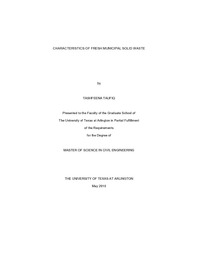
ATTENTION: The works hosted here are being migrated to a new repository that will consolidate resources, improve discoverability, and better show UTA's research impact on the global community. We will update authors as the migration progresses. Please see MavMatrix for more information.
Show simple item record
| dc.contributor.author | Taufiq, Tashfeena | en_US |
| dc.date.accessioned | 2010-07-19T19:54:34Z | |
| dc.date.available | 2010-07-19T19:54:34Z | |
| dc.date.issued | 2010-07-19 | |
| dc.date.submitted | January 2010 | en_US |
| dc.identifier.other | DISS-10596 | en_US |
| dc.identifier.uri | http://hdl.handle.net/10106/4880 | |
| dc.description.abstract | The characteristics of fresh municipal solid waste (MSW) are critical in planning, designing, operating or upgrading solid waste management systems. Physical composition, moisture content, compacted unit weight, permeability are the most important MSW characteristics to be considered in planning a system. When the landfill is operated as enhanced leachate recirculation (ELR) landfill, the physical and hydraulic characteristics are of particular interest in determining the amount of moisture to be recirculated and to design the leachate recirculation and gas collection systems. The current study presents the physical and hydraulic characteristics of MSW collected from the working face of Denton Landfill. The results are based on 20 (twenty) 30-lb bags of MSW samples collected over two seasons: May 2009 and August 2009. It was evaluated that ten samples are adequate to provide reliable results within 90% confidence interval about mean for each sample sets. For the MSW sample of May, 2009, the moisture content of the fresh MSW was determined to vary between 34.0% and 48.02% on wet weight basis. The unit weight varied from 27.6 lb/ft³ to 38.55 lb/ft³ with an average of 33.88 lb/ft³ at initial moisture content. The hydraulic conductivity was found to be in the range of 10⁻³ cm/sec (10⁻⁵ to 10⁻⁴ ft/sec) at a density of 5.32 kN/m³ (33.88 lb/ft³). For the MSW sample of August, 2009, the moisture content of the fresh MSW was determined to vary between 30.3% and 42.5% on wet weight basis. The unit weight varied from 26.4 lb/ft³ to 50.55 lb/ft³ with an average of 33.88 lb/ft³ at initial moisture content. The hydraulic conductivity was again found to be in the range of 10⁻³ cm/sec (10⁻⁵ to 10⁻⁴ ft/sec) at a density of 5.32 kN/m³ (33.88 lb/ft³). The overall average physical composition of the MSW of Denton Landfill is: Paper (41.27%), Plastic (17.65%), Food Waste (3.03%), Textile & Leather (4.07), Wood & yard waste (8.72%), Metals (5.36%), Glass (1.18%), Styrofoam & sponge (1.24%), Construction debris (4.78%), and Others (18.95%). Of the total weight, 57% is degradable and 43% is non-degradable. The unit weight of the solid waste was 35.85 pcf (5.63 kN/m³) and the moisture content on wet basis is 37.45% on average. The permeability was 3.48x10⁻³ cm/sec at about 33.88 pcf density. The composition indicated that the waste is high in Paper and Plastics content but very low in food content. The unit weight and permeability results found from present study closely comply with values published in literature but the moisture content is slightly higher. | en_US |
| dc.description.sponsorship | Hossain, Sahadat | en_US |
| dc.language.iso | EN | en_US |
| dc.publisher | Civil & Environmental Engineering | en_US |
| dc.title | Characteristics Of Fresh Municipal Solid Waste | en_US |
| dc.type | M.S. | en_US |
| dc.contributor.committeeChair | Hossain, Sahadat | en_US |
| dc.degree.department | Civil & Environmental Engineering | en_US |
| dc.degree.discipline | Civil & Environmental Engineering | en_US |
| dc.degree.grantor | University of Texas at Arlington | en_US |
| dc.degree.level | masters | en_US |
| dc.degree.name | M.S. | en_US |
| dc.identifier.externalLink | https://www.uta.edu/ra/real/editprofile.php?onlyview=1&pid=963 | |
| dc.identifier.externalLinkDescription | Link to Research Profiles | |
Files in this item
- Name:
- Taufiq_uta_2502M_10596.pdf
- Size:
- 7.116Mb
- Format:
- PDF
This item appears in the following Collection(s)
Show simple item record


